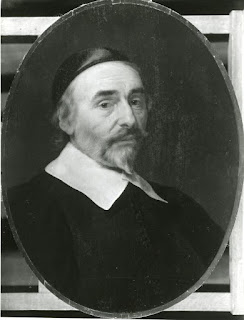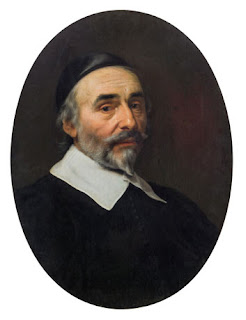by Marc Masurovsky
 |
| Portrait of a man, Bartholomeus van der Helst |
“Portrait of a man” by Bartholomeus van der Helst, once belonged to the renown Schloss brothers in France. Their collection of over 330 Old Master paintings became the focal point of an intense rivalry between the wartime Vichy government and the plundering agents of the Nazi regime, especially Goering’s men, their trusted art advisors and senior officials of the Einsatzstab Reichsleiter Rosenberg (ERR).
In a farcical race against time, both Vichy and the Germans attempted to be the first to seize the collection. The Germans got the upper hand as they allowed the French to seize it only to force them to hand it over and transfer it to Paris.
The paintings were sorted, inventoried, catalogued and shipped for the most part through the Jeu de Paume to the halfway house to the Linz Museum, the Fuhrerbau, located in the heart of Munich.
Shortly before the American army took control of Munich on April 30, 1945, the vast majority of looted art works stored at the Fuhrerbau were removed by unknown parties and their contents scattered. In the years that followed, American agents working in tandem with the Munich criminal police found not more than 100 paintings which had been stolen from the Fuhrerbau. Schloss 91 was not one of them.
In fact, 90 per cent of the paintings stolen from the Fuherbau remain unaccounted for. Some resurface on occasion. The most famous are the Schloss collection paintings which the French government does not seem anxious to recover on behalf of the Schloss family.
Well, here is an opportunity that might be missed for the 20th time as a looted, unrestituted painting belonging to the Schloss heirs is offered for sale in Vienna, Austria on April 12, 2016. 
The provenance indicates that it was nowhere to be found during WWII and names Adolphe Schloss as a prewar owner, forgetting to mention that his heirs were also the rightful owners. That takes guts.
Will someone please say something and stop this sale?
Update:
According to the Kimsky auction house, the looted nature of the painting is obvious. Together with the consignor, it is willing to explore how to apply the Washington Principles to this situation, namely reach a “fair and just solution” or a financial settlement which would allow the painting to be sold.
The solution rests entirely in the hands of the family which is based in Paris, and in the hands of law enforcement–the painting is listed on the Interpol website as well as on at least one looted art database, the ERR/Jeu de Paume database. It is high time for someone to act and not let this looted painting be sold without a resolution that has been offered by the consignor–a first–and the Viennese auction house–a first as well. We saw recently another Viennese auction house pretend that a bust by Houdon, Diane, resembled one which had been plundered from a Polish castle by German troops. A simple stroll on Poland’s looted art website would have revealed in 15 minutes the fact that the Houdon in Vienna was one and the same as the one claimed by the Polish government.
In sum, some progress is being made in the art market whereby it is noticeable that consignors and auction houses, when motivated, can do the right thing.
It would be a shame for the Schloss heirs to let this opportunity slip by as well as Austrian and French law enforcement agencies to sit tight and not intervene.